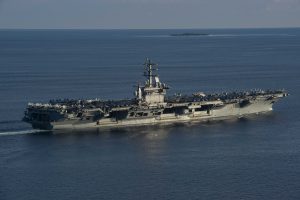By Abhijnan Rej
China launched two missiles into the South China Sea on the morning of August 26 in a drill, the South China Sea Morning Post (SCMP) reports. In a move designed to signal Washington as well as regional powers that Beijing is unafraid of a military confrontation should the U.S. challenge its resolve, it tested two missiles: a DF-21D and a DF-26B. SCMP reports that the DF-26B was launched from Qinghai province, while the DF-21D was fired from Zhejiang. According to its source, both missiles headed off to a region between the coastal Hainan province and the Paracel Islands in the South China Sea. While the precise operational objective behind these drills remain unknown, according to the SCMP report, “the landing areas were within a zone that Hainan maritime safety authorities said on Friday would be off limits because of military exercises from Monday to Saturday.”
The DF-21D is the world’s first anti-ship ballistic missile (ASBM) – colloquially dubbed a “carrier killer” because of its ability to hold an aircraft carrier at risk – with a reported range between 1,450 and 1,550 kilometers. It can defeat the Aegis Combat Systems that guard key surface combatants operated by the U.S. and allies in the region. The DF-26 has a range between 3,000-4,000 kilometers allowing it to strike U.S. bases in Guam in a land-attack role. The Center for Strategic and International Studies’ (CSIS) MissileThreat website notes that the PLA has not publicly announced whether it has ever tested an anti-ship variant of the DF-26 missile against moving targets at sea. It does however note that “the PLA Rocket Force conducted an operational test of a new missile in the Bohai Sea” in May 2017 which many analysts speculated to be a DF-26 ASBM.
Road-mobile ASBMs like DF-21D and DF-26B form crucial components in China’s area denial strategy for the South China Sea. China had fired at least one missile there last July. Today’s test come at a time when U.S. naval activity – coupled with political assertiveness – seeks to generate significant pressure on Beijing in order to curb its ambitions. Over the past few months, U.S. carrier strike groups have carried out exercises in the South China Sea in order to both assure allies about American commitment to upholding the regional rules-based order as well as demonstrate U.S. military superiority to China.
In July, two U.S. aircraft carriers arrived in the region, operating together for the first time since 2014. Commenting on the significance of this show of strength, a former director of operations at the U.S. Pacific Command’s Joint Intelligence Center had told CNN: “The different scale of demonstrated combat power between the People Liberation Army Navy’s and United States Navy’s exercises will be noticeable. That sends both a military and geopolitical signal to China and the region.”
In October last year, China unveiled the hypersonic DF-100/CJ-100 ASBM. Moving at the more than five times the speed of sound, such missiles stand to seriously bolster Chinese denial capabilities.

No comments:
Post a Comment